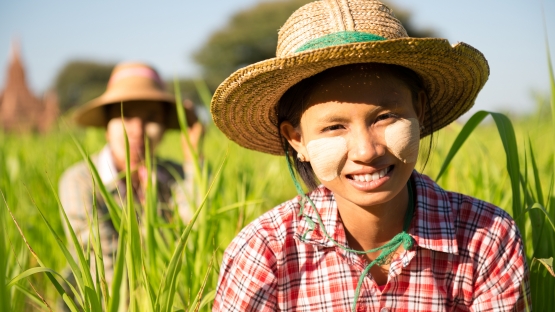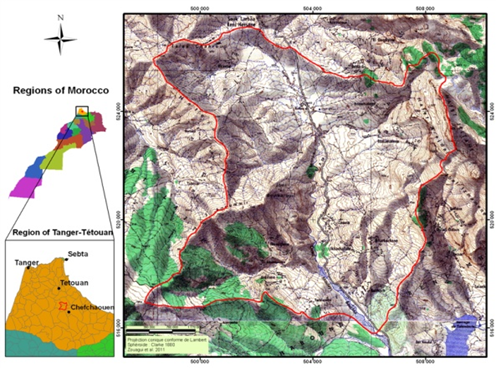More than 50% of the Earth's land is moderately or severely affected by soil degradation. Without sustainable practices, this trend will unfortunately continue, jeopardizing biodiversity, threatening global food prices, and endangering more than 2.6 billion small-scale farmers whose livelihoods depend on healthy soil. Although the challenge is great-both in size and complexity-the UN celebration of World Soil Day on 4 December reminds us that we have the tools to confront, and eventually resolve, the challenge.
Whereas it may take 1,000 years for a single centimetre of healthy soil to form, that same plot of land can be degraded or destroyed in moments. This is the central message of World Soil Day-arable land is fragile and limited, which means that our land-use must be respectful and sustainable. Through its technical cooperation (TC) programme, the IAEA works closely with its Member States to deploy sustainable, proven nuclear techniques that assess soil erosion (the main contributor to land degradation), improve soil fertility, reduce water-use inefficiencies, and boost crop yields.
Beyond its capacity-building efforts, however, the IAEA has built and is leveraging partnerships with other United Nations organizations-including the United Nations Environment Programme (UNEP) and the United Nations Convention to Combat Desertification (UNCCD)-to contribute more effectively to national sustainable soil management practices and policies.
UNCCD is the sole legally-binding international agreement which links environment, development and the promotion of healthy soils. The Convention's 195 Parties work to alleviate poverty in the drylands, maintain and restore the land's productivity, and mitigate the effects of drought. All IAEA Member States have ratified the Convention. The IAEA is helping Member States to fulfill their obligations arising from the Convention, and is contributing to the assessment of soil degradation and soil erosion as part of the Convention's National Action Plans (NAP) to combat desertification.
Approximately 6,000 participants gathered for the two-week Conference of the Parties, which adopted 35 decisions following deliberations on agenda items related to desertification, land degradation and drought (DLDD), including how to pursue land degradation neutrality (LDN) and how to align the UNCCD's goals and action programmes with the recently adopted Sustainable Development Goals (SDGs).
The Conference of the Parties of the UNCCD brings together the Ministers of Environment, national environmental decision makers, the national focal points of the UNCCD (Ministry of Environment), UN Agencies, the CGIAR research centers, soil scientists and researchers, and NGOs. It is therefore the place to be for effective and targeted outreach and partnership building with the aim of linking up with the science community, and environmental decision makers from all regions.
On 19 October, on the margins of the 12th Conference of the Parties (COP12) of UNCCD, the IAEA organized a side event to demonstrate the effectiveness and utility of nuclear techniques in fighting soil erosion. Organized jointly by the Water Soil and Climate Division of the National Centre for Nuclear Energy, Sciences and Technology (CNESTEN) of Morocco and the Department of Nuclear Analysis and Techniques, National Institute for Nuclear Science and Technology (INSTN), Madagascar, and with participation of the UNCCD national focal points of these countries, the event highlighted the importance of data derived from nuclear soil science for improving quantitative analysis and informing evidence based decision-making, necessary for effective land-use policies.
Soil Science and its contribution to Sustainable Land Management
The side event highlighted the importance of soil science for sustainable land management. The soil maps developed by the IAEA, in addition to the soil erosion data collected from IAEA supported soil assessment activities, are supporting the Moroccan government as it implements its National Action Plan (NAP) to combat land degradation.
Partnerships with environmental decision makers are essential in the promotion of soil science. Nuclear soil science needs to be embedded not only in the national research agenda, but into the national environmental decision-making agenda as well. Exemplary of this approach is the IAEA's support of the regional project "Supporting Innovative Conservation Agriculture Practices to Combat Land Degradation and Enhance Soil Productivity for Improved Food Security" in Africa. The Division of Water Soil and Climate of the National Centre for Nuclear Energy, Sciences and Technology works in close cooperation with the Center for Forestry Research and the High Commission of Forest, Water and Combating Desertification to ensure that the soil research responds to national needs and helps implement the National Action Plan of the UNCCD.
In the "My Bouchta" watershed, in the north of Morocco, fallout radionuclides and stable Isotopes were used to assess soil erosion and soil redistribution rates necessary for devising a watershed management plan.
At the conclusion of the 12th Conference of the Parties, a breakthrough agreement was reached: the adoption of Land Degradation Neutrality as a target. All countries will now formulate voluntary targets to achieve LDN according to their specific national circumstances and development priorities.
The essential role played by soils in promoting human prosperity is undeniable-Soils provide the basis for healthy food production; they support our planet's biodiversity; they store and filter water, reducing the harmfulness of floods and droughts; and they help us combat climate change by depositing and releasing carbon. As the International Year of Soils draws to a close, we must reflect on how expanding cities, deforestation and pollution have harmed soils, and we must consider how nuclear techniques and international cooperation might heal them.



